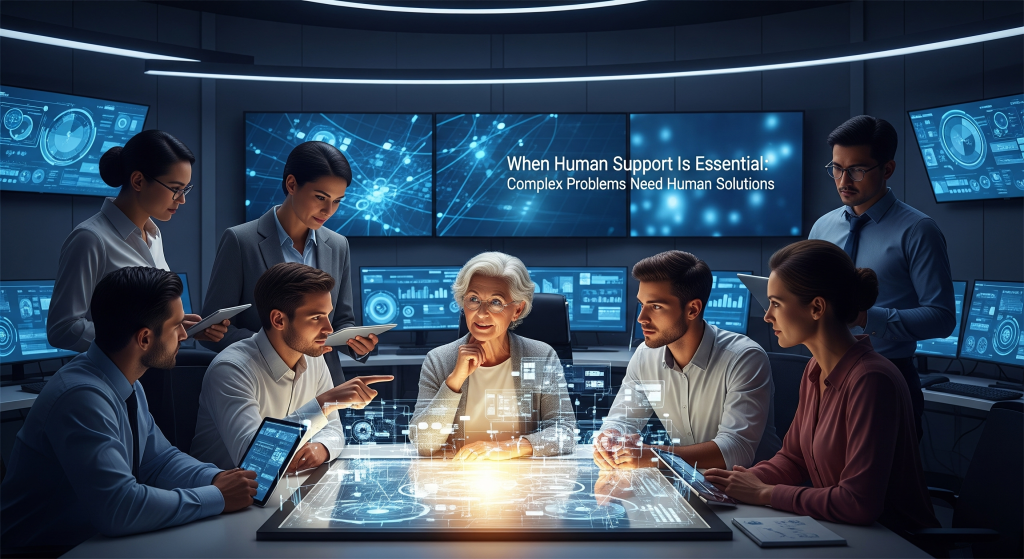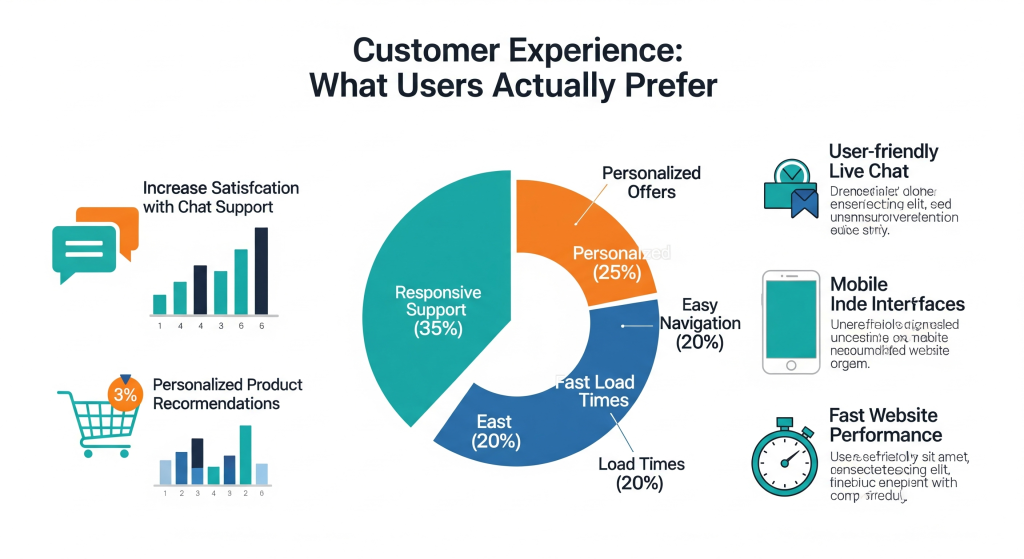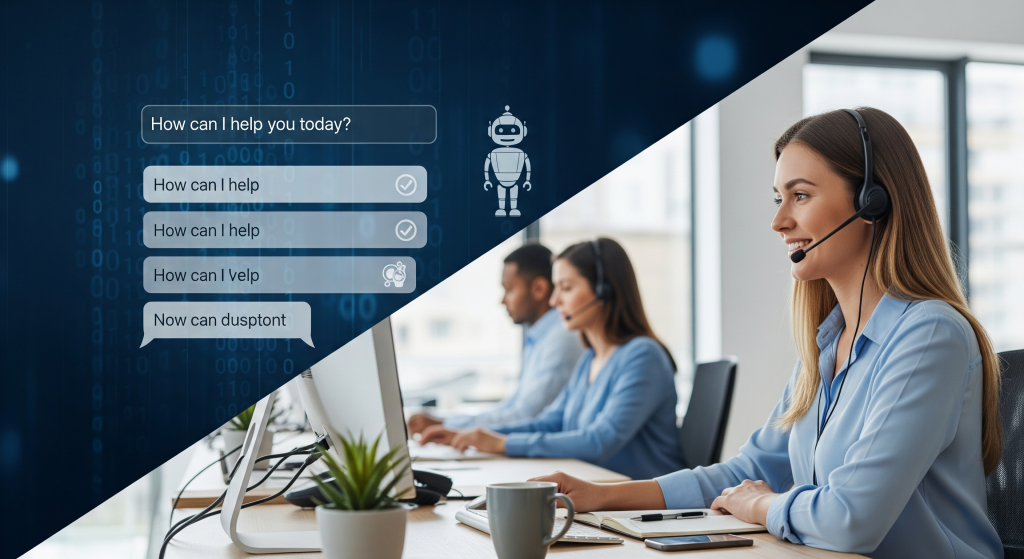Customer service has changed completely in the last five years. Walk into any business today and you’ll see chatbots greeting customers online while human agents handle complex issues behind the scenes. But here’s what most people don’t know: choosing between chatbots and human support isn’t about picking sides. It’s about knowing when each one works best for your specific needs.
My name is Richard Boren, and I’ve spent five years working directly with customer service systems across different industries. I’ve watched chatbots fail spectacularly at simple tasks and seen human agents solve problems in minutes that took AI hours to understand. I’ve also seen chatbots handle thousands of customers simultaneously while human teams struggled with basic volume. This experience taught me something important: both have their place, but only when used correctly.
The real question isn’t which one is better. It’s which one will actually solve your problem without wasting your time. Let me show you exactly when to use each approach and how to get the best results from both.
What Are Customer Service Chatbots and How Do They Actually Work?

Customer service chatbots are automated programs that handle customer questions through text or voice conversations. They use artificial intelligence to understand what you’re asking and provide relevant answers or solutions. Think of them as digital assistants that never sleep, never take breaks, and can talk to hundreds of people at once.
Modern chatbots work in three main ways. Rule-based chatbots follow preset scripts and decision trees. They’re like interactive FAQ pages that guide you through specific paths based on your answers. AI-powered chatbots use machine learning to understand natural language and provide more flexible responses. Hybrid chatbots combine both approaches, using rules for simple tasks and AI for complex conversations.
The technology behind these systems has improved dramatically. Five years ago, most chatbots could barely understand basic questions. Today’s advanced systems can handle multiple languages, understand context from previous conversations, and even detect emotions in your messages. They connect directly to company databases, payment systems, and support tools to provide real-time assistance.
Here’s what makes modern chatbots different from those frustrating automated phone systems: they learn from every interaction. When thousands of customers ask similar questions, the chatbot gets better at recognizing patterns and providing accurate answers. This means the service actually improves over time instead of staying stuck with the same limited responses.
When Customer Service Chatbots Excel: The Sweet Spot for Automated Support
Chatbots shine brightest when handling straightforward, repetitive tasks that don’t require human judgment or complex problem-solving. I’ve seen them process simple requests in under 30 seconds that would take human agents 5-10 minutes including wait time.
Immediate Response Scenarios
Chatbots work best for instant information needs. Checking account balances, tracking shipments, finding store hours, or getting basic product details happen immediately. No hold music, no waiting for the next available agent. You type your question and get an answer within seconds.
Password resets and basic account changes are perfect chatbot territory. These tasks follow clear steps that don’t vary much between customers. The chatbot can verify your identity, send reset links, and guide you through the process faster than explaining the same steps to a human agent.
High-Volume, Low-Complexity Issues
Simple troubleshooting follows predictable patterns that chatbots handle efficiently. “My internet isn’t working” leads to a systematic check of common issues: power connections, router status, service outages in your area. The chatbot walks you through each step and escalates to human support only when basic solutions don’t work.
Frequently asked questions represent the perfect use case for chatbots. Return policies, shipping information, product specifications, and basic how-to guidance don’t require human expertise. Chatbots deliver consistent, accurate answers every time without the variability that comes with different human agents.
After-Hours Support
Chatbots provide 24/7 availability that human teams can’t match cost-effectively. When you need help at 2 AM or during holidays, chatbots continue working. They can’t solve everything, but they handle urgent issues like account lockouts, emergency contact information, or basic technical problems that can’t wait until business hours.
Chatbot AdvantagesBest Use CasesInstant response timeAccount inquiries, order status24/7 availabilityPassword resets, basic troubleshootingConsistent answersFAQ responses, policy informationMultiple language supportInternational customer baseCost-effective scalingHigh-volume, simple requests
When Human Support Is Essential: Complex Problems Need Human Solutions

Human agents become essential when problems require empathy, complex reasoning, or creative problem-solving that goes beyond standard procedures. Some situations simply can’t be automated without losing the human touch that customers need.
Emotional and Sensitive Situations
Billing disputes, service cancellations, or complaints about poor experiences require human understanding. When customers are frustrated, confused, or upset, they need someone who can listen, show empathy, and work through problems with patience. Chatbots can’t read emotional nuance or provide the reassurance that comes from talking to another person.
Medical, legal, or financial advice situations demand human expertise. These areas involve complex regulations, personal circumstances, and potential liability issues that require professional judgment. A chatbot might provide general information, but humans make the critical decisions and take responsibility for advice given.
Complex Technical Problems
Multi-step technical issues that require back-and-forth troubleshooting work better with human agents. When solutions involve testing different approaches, checking multiple systems, or thinking creatively about unusual problems, human agents can adapt their approach based on what they discover during the conversation.
Product customizations, special orders, or unique business requirements need human creativity and problem-solving. Humans can think outside standard procedures to find solutions that work for specific situations. They can also coordinate with other departments, supervisors, or technical teams when problems require specialized knowledge.
Relationship Building and Trust
High-value customers or complex business accounts benefit from human relationships. Building long-term partnerships requires understanding business goals, remembering previous conversations, and making judgment calls about exceptions or special arrangements. Humans excel at reading between the lines and understanding what customers really need.
Sales conversations involving significant purchases work better with human agents who can understand customer priorities, answer detailed questions, and provide personalized recommendations. The trust factor in major buying decisions often requires human interaction to feel comfortable moving forward.
The Hybrid Approach: Getting the Best of Both Worlds
The most effective customer service systems don’t force you to choose between chatbots and humans. They use both strategically, starting with automated assistance and seamlessly transitioning to human support when needed.
Smart Escalation Systems
Modern systems use intelligent routing that analyzes your request and determines the best path forward. Simple questions stay with chatbots. Complex issues go directly to human agents. The key is making this transition smooth and preserving all the information you’ve already provided.
Effective escalation preserves conversation context. When a chatbot transfers you to a human agent, that agent should see everything you’ve already discussed. No repeating your account number, explaining your problem again, or starting from scratch. Good systems make this handoff invisible from your perspective.
Progressive Problem Resolution
The hybrid approach starts with quick chatbot solutions for common issues. If those don’t work, the system escalates to more advanced troubleshooting with human oversight. For complex problems, human agents take over completely but can access all the diagnostic information the chatbot already gathered.
This layered approach reduces wait times for simple issues while ensuring human expertise is available when needed. Customers get fast resolution for easy problems and thorough attention for complicated ones.
Continuous Learning Integration
Human agents provide feedback that improves chatbot performance over time. When agents frequently handle issues that chatbots escalate, developers can update the automated systems to handle similar problems in the future. This creates a learning loop that continuously improves the overall service experience.
Cost Analysis: The Real Numbers Behind Each Approach
Understanding the economics behind customer service options helps explain why companies make certain choices and what it means for your experience as a customer.
Chatbot Economics
Chatbots cost significantly less per interaction than human agents. Initial development requires substantial investment, but operational costs drop dramatically once the system is running. A single chatbot can handle thousands of simultaneous conversations, while human agents typically manage 1-3 conversations at once.
Maintenance costs for chatbots include software updates, training data management, and integration with other systems. However, these costs remain relatively fixed regardless of conversation volume. Scaling up doesn’t require hiring and training new staff, just adding server capacity.
Human Support Costs
Human agents require ongoing salaries, benefits, training, and management overhead. Each new agent adds significant recurring costs beyond their base pay. Training time for complex products or services can take weeks or months before new agents become fully productive.
Peak demand creates additional challenges for human support teams. Companies must either staff for maximum capacity (expensive) or accept longer wait times during busy periods. Chatbots handle volume spikes without additional cost, making them attractive for businesses with variable demand.
Cost FactorChatbotsHuman SupportInitial setupHighLowPer interactionVery lowModerate to highScaling costsMinimalLinear increaseTraining expensesOne-time developmentOngoing per agentPeak capacityNo additional costRequires overstaffing
Customer Experience: What Users Actually Prefer

Customer preferences for chatbots versus human support depend heavily on the situation, the quality of the automated system, and individual comfort levels with technology.
Speed vs. Quality Tradeoffs
Customers consistently prefer chatbots for quick, straightforward requests where speed matters more than detailed explanation. Checking order status, finding basic information, or completing simple transactions work well with automated systems. The instant response time often outweighs any limitations in conversation quality.
For complex problems, customers prefer human agents even when it means longer wait times. Research shows people will wait for human support when they perceive their issue as complicated, urgent, or requiring personal attention. The trade-off between speed and quality becomes a conscious choice.
Trust and Confidence Factors
Customer trust in chatbots varies significantly by age, technical comfort, and previous experiences. Younger customers often prefer chatbots for routine tasks but still want human options for important issues. Older customers frequently prefer human contact regardless of the complexity level.
Industry context affects trust levels substantially. Financial services, healthcare, and legal situations generate higher demands for human support due to the sensitive nature of the information and potential consequences of mistakes. E-commerce and tech support show higher chatbot acceptance rates.
Success Rate Measurements
Effective chatbot implementations achieve 80-90% success rates for their intended use cases. However, this statistic can be misleading if companies define “success” too narrowly. True success means customers leave satisfied without needing additional support, not just completing the chatbot conversation.
Human agents typically show higher overall satisfaction scores but lower efficiency ratings for simple tasks. The relationship between efficiency and satisfaction creates an interesting dynamic where the “best” choice depends on what customers value most in each specific situation.
Technology Limitations: What Each Approach Can’t Do Well
Understanding the boundaries of both chatbots and human support helps set realistic expectations and choose the right approach for your specific needs.
Chatbot Limitations
Context switching remains a significant challenge for chatbots. If you start asking about one problem and then mention a related issue, many chatbots struggle to maintain coherent conversation flow. They might restart the conversation or provide answers that don’t account for the full context of your situation.
Nuanced language interpretation still trips up automated systems. Sarcasm, implied meanings, cultural references, or complex explanations often lead to misunderstandings. Chatbots work best with direct, literal communication using standard terminology.
Exception handling represents another major limitation. When your situation doesn’t fit standard categories or requires bending normal procedures, chatbots typically can’t help. They’re designed for common scenarios and struggle with unique circumstances that require creative solutions.
Human Support Limitations
Human agents can’t maintain perfect consistency across large teams. Different agents might provide different answers to the same question based on their training, experience, or interpretation of company policies. This variability can frustrate customers who expect uniform service quality.
Availability constraints limit human support effectiveness. Even 24/7 human support teams often reduce staffing during off-peak hours, leading to longer wait times. Humans also need breaks, vacation time, and sick days that can affect service availability.
Knowledge limitations affect individual agents differently. While chatbots can access entire knowledge bases instantly, human agents might not know answers to specialized questions outside their specific training areas. This can lead to transfers between departments or longer resolution times.
Industry-Specific Applications: Where Each Approach Works Best
Different industries have discovered optimal combinations of chatbot and human support based on their unique customer needs and business requirements.
E-commerce and Retail
Online retail uses chatbots extensively for order tracking, return processing, and product recommendations. These systems excel at accessing order databases, processing routine requests, and handling the high volume of simple questions that e-commerce generates. Human agents focus on complex product questions, dispute resolution, and high-value customer relationships.
Financial Services
Banks and financial institutions use chatbots for account balance inquiries, transaction history, and basic account management. However, they maintain strong human support for loan applications, investment advice, and fraud resolution. The combination of automated efficiency for routine tasks and human expertise for complex financial decisions creates effective service coverage.
Healthcare
Medical organizations use chatbots for appointment scheduling, prescription refills, and basic health information. Human nurses and medical professionals handle symptom assessment, test result discussions, and treatment plan conversations. The separation between administrative tasks and medical judgment creates clear boundaries for each approach.
Technology Support
Software companies leverage chatbots for common troubleshooting steps, account issues, and documentation searches. Technical problems that require detailed diagnosis, custom solutions, or software modifications escalate to human engineers. This tiered approach filters routine issues while preserving human expertise for complex technical challenges.
IndustryChatbot FocusHuman FocusE-commerceOrder status, returns, basic product infoComplex products, disputes, VIP customersFinanceAccount inquiries, transactionsLoans, investments, fraud issuesHealthcareScheduling, refills, general infoMedical advice, test results, treatmentTechnologyBasic troubleshooting, documentationComplex technical issues, custom solutions
Implementation Best Practices: How to Set Up Effective Customer Service
Companies that successfully implement customer service systems follow specific strategies that maximize the strengths of both chatbots and human agents while minimizing their weaknesses.
Design Principles for Success
Clear escalation paths prevent customer frustration when chatbots reach their limits. Users should always know how to reach human support without jumping through multiple hoops or repeating information. The best systems provide obvious “speak to human” options at every stage of the chatbot interaction.
Conversation handoffs must preserve all context and information. When transitioning from chatbot to human agent, nothing should be lost. The human agent should see the complete conversation history, any diagnostic information gathered, and clear notes about why the escalation occurred.
Training and Maintenance Requirements
Chatbot training requires ongoing attention to conversation logs, success rates, and customer feedback. Teams must regularly review failed interactions, update response libraries, and refine the AI’s understanding of customer language patterns. This isn’t a “set it and forget it” technology.
Human agent training must include chatbot integration knowledge. Agents need to understand what the chatbot can and cannot do, how to interpret information passed from automated systems, and when to recommend chatbot solutions for future similar issues.
Measuring Success Effectively
Resolution rate tracking should measure complete problem solving, not just conversation completion. A chatbot that answers questions but doesn’t actually solve problems creates more work for human agents later. Success metrics must account for whether customers need additional support after the initial interaction.
Customer satisfaction surveys should differentiate between chatbot and human interactions to identify specific areas for improvement. Understanding why customers prefer one approach over another in different situations helps optimize the overall service strategy.
Future Trends: How Customer Service Is Evolving
The customer service landscape continues evolving rapidly as technology improves and customer expectations change. Understanding these trends helps predict what service options will be available and how they might affect your experience.
AI Advancement Impact
Artificial intelligence capabilities expand regularly, allowing chatbots to handle increasingly complex conversations. Natural language processing improvements mean chatbots understand context better and provide more relevant responses. However, this doesn’t necessarily mean they replace human agents in all situations.
Voice-based chatbots are becoming more sophisticated, handling phone conversations that previously required human agents. These systems can understand spoken language, detect emotional tone, and respond naturally through speech synthesis. The technology bridges the gap between traditional phone support and text-based chatbots.
Integration and Personalization
Customer service systems increasingly integrate with other business tools to provide personalized experiences. Chatbots access purchase history, previous support interactions, and customer preferences to tailor their responses. This personalization makes automated support feel more human-like and relevant.
Omnichannel support ensures consistent experiences across different communication methods. Whether you start a conversation through a mobile app, continue it via email, or finish with a phone call, the system maintains continuity and context throughout the process.
Changing Customer Expectations
Customers now expect immediate responses for simple questions and human availability for complex issues. This dual expectation drives the hybrid approach that most successful companies adopt. Neither pure automation nor pure human support meets modern customer needs effectively.
Self-service preferences continue growing, especially among younger customers who prefer finding answers independently rather than waiting for support. Companies respond by improving their knowledge bases, video tutorials, and guided troubleshooting tools that complement both chatbot and human support options.
Frequently Asked Questions
How do I know if a chatbot can solve my problem?
Start with the chatbot if your issue involves checking information, following standard procedures, or completing routine tasks. Escalate to human support if you need exceptions to normal policies, have multiple related problems, or feel frustrated with the automated responses.
What should I do if the chatbot doesn’t understand my question?
Try rephrasing your question using simpler, more direct language. Avoid slang, complex sentences, or multiple questions at once. If the chatbot still doesn’t understand, ask for human support rather than continuing to struggle with the automated system.
Are chatbots secure for sensitive information?
Modern chatbots use the same security protocols as human support systems, including encryption and secure data handling. However, avoid sharing highly sensitive information like full social security numbers or detailed financial information unless you’re certain about the system’s security measures.
How long should I wait for human support versus using a chatbot?
Use chatbots first for immediate needs, especially during peak hours when human wait times are longest. If the chatbot can’t help and your issue isn’t urgent, consider trying human support during off-peak hours for faster service and more agent availability.
Conclusion
The choice between customer service chatbots and human support isn’t really a choice at all. Both have specific strengths that work best in different situations. Smart customers understand when to use each approach, while successful companies provide both options seamlessly integrated.
Chatbots excel at speed, availability, and handling routine tasks efficiently. Human agents provide empathy, complex problem-solving, and creative solutions for unique situations. The future belongs to hybrid systems that combine these strengths intelligently.
Your goal as a customer should be getting your problem solved quickly and effectively. Sometimes that means starting with a chatbot for immediate help. Other times it means going straight to human support for complex issues. Understanding when to use each approach saves time and reduces frustration while getting better results from both options.
The customer service world will continue evolving, but the fundamental principle remains constant: use the right tool for the specific job. Whether that tool is automated or human depends on your specific needs, not abstract preferences about technology versus people.



